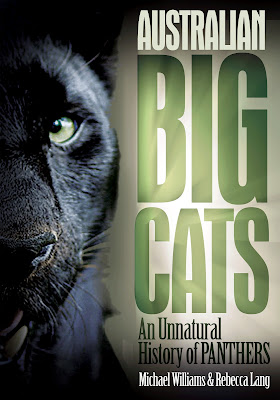When I wrote my first book, a school textbook, it was all very straightforward – I penned the words and someone else sculpted them into a more pleasing form, found illustrations to support what I was saying and pulled it all together in a nice, shiny little package called a book.
Many were printed and found homes far and wide in libraries and schools across Australia. As it was a commissioned project, it was a reasonably pain-free endeavor. I was paid a small up-front sum for my work and registered with the
Australian Public Lending Scheme (PLR), which pays authors a royalty every time someone borrows one of their books (a worthy scheme that has paid me in excess of $6000 since my first book was printed).
Fast forward five years and my second co-written book,
Australian Big Cats: An Unnatural History of Panthers – a tome on folklore, and a labour of love – had been pitched to four mainstream publishing houses without any interest.
I could have persevered or found an agent but, as a former journalist, and one with newspaper layout experience, I was actually itching to give self-publishing a go. I was confident I could pull together a book every bit as readable and eye-catching as any mainstream tome – I just needed to find out how to do it.
And rather than bore you in real time as to how all that happened, I’ll give it to you in a nutshell – I researched all of the self-publishing avenues available and eventually jumped on board with
Lightning Source, creating a company name to give me entre to the printing company’s vast resources.
Next I found myself a talented graphic designer. I’m afraid when it comes to books, looks count far more than they should – and I was desperately passionate that my book should be up there in the supermodel stakes. Fortunately a good friend of mine also happened to be a gun graphic designer, and his cover would later prove to be a key selling point.
While project-managing the book’s layout and cover, I bought an ISBN and a domain name and taught myself how to build a basic website using templates from the iWeb program on my (Apple) iMac computer, which previously worked with the
Apple.com server to host my website. This hosting facility no longer exists and I have been forced to bone up further on website building and hosting.
The site -
www.australianbigcats.com.au - went live with the book cover image and a giant countdown clock, and I began to promote it in chat groups and blogs across the web. The marketing of the book had begun in earnest and it hadn’t even seen a printing press! (I’ll talk more about the marketing side of things in a future post.)
Around the same time I created a
Facebook page for the book, which now boasts more than 500 fans (not bad for a niche book!). Incidentally, the website has now received more than 17,600 visits.
With the help of my graphic designer we uploaded the book cover image and content to Lightning Source and waited two weeks or thereabouts for the formatting to take place at their end.
At that time Lightning Source had no presence in Australia so I had to source a local digital printer to print an initial run of 500 books for in-store distribution. Altogether we printed 850 books before making the decision – based on cost, time and distribution - to print solely through Lightning Source.
This had the added attraction of being ‘print on demand’, meaning we wouldn’t have to fill our house with boxes of books – instead, they would be printed as they were ordered by readers from various online bookstores.
Two years on and sales are steady and, thanks to the Lightning Source set-up, I sit back and wait for the money to roll in while I work on other projects.
At present I’m contemplating an e-book version of our book – how quaint! I hear some of you cry – but we have had our reasons for holding off, both marketing and software-related.
We’ve also since re-published a book,
Savage Shadow: The Search for the Australian Cougar, on behalf of another late author’s family using the same method – another labour of love with a similarly brilliant cover (if we do say so ourselves) – so time has been finite between work and…I want to say ‘play’, but really it’s more work! I’m also considering a permanent price drop to further encourage sales.
I wouldn’t want you to think our printing projects haven’t been without stumbling blocks – there have been plenty! They have included formatting errors requiring subsequent uploads, undetected editing errors, missing stock, poorly printed books (it does happen), booksellers slow to pay for sold stock (thus holding up the financing of subsequent local print runs), distribution issues and various other gremlins.
But it has been a fantastic experience, and one I will most definitely repeat. Having already trod the path twice, I will be more prepared for the next project and, with the burgeoning popularity of e-readers and e-books, in a much better position to reach potential future readers.
Self-publishing isn’t a river of gold for everyone, but it is a fantastic opportunity for would-be publishers and authors.
The best advice I can give is if you want to be taken seriously and attract readers, then spend the time and money to bring your manuscript up to scratch, and present your final product in the best possible light. That means hiring editors to polish your prose, and graphic designers to work their magic with your book's layout and cover. And becoming your own project manager/marketing manager.
Your readers will love you, booksellers will be bowled over by you, and maybe, if it’s the sort of luck you’re after, an agent or mainstream publisher will fall in love with you too!

































